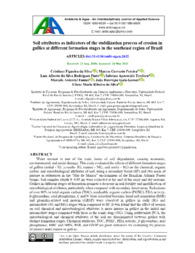Soil attributes as indicators of the stabilization process of erosion in gullies at different formation stages in the southeast region of Brazil.
Soil attributes as indicators of the stabilization process of erosion in gullies at different formation stages in the southeast region of Brazil.
Author(s): SILVA, C. F. da; PEREIRA, M. G.; RODRIGUES, L. A. da S.; TEODORO, S. A.; MARCELO ANTONIOL FONTES; GAIA-GOMES, J. H.; SILVA, E. M. R. da
Summary: Water erosion is one of the main forms of soil degradation, causing economic, environmental, and social damage. This study evaluated the effects of different formation stages of gullies (initial - IG; juvenile- JG; mature - MG; and senile - SG) on the chemical, organic carbon and microbiological attributes of soil, using a secondary forest (SF) and two areas of pasture as references in the ?Mar de Morros? environment of the Brazilian Atlantic Forest biome. Soil samples (depth 0?0.05 m) were collected at the end of the rainy and dry seasons. Gullies in different stages of formation promote a decrease in soil fertility and modification of microbiological attributes, particularly when compared with secondary forest areas. Reductions of over 60% in total organic carbon (TOC), oxidizable organic carbon (POXC), FDA activity, β-glycosidase, acid phosphatase, C and N from microbial biomass, basal soil respiration (BSR) and glomalin-related soil protein (GRSP) were observed in gullies in early (IG) and intermediate (JG and MG) stages when compared to SF. It was found that the effect of erosion on soil chemical and microbiological attributes is more intense in gullies in the initial and intermediate stages compared with those in the senile stage (SG). Using multivariate PCA, the microbiological and chemical attributes of the soil are discriminated between gullies with distinct formation stages. Chemical attributes, TOC, POXC, FDA activity, β-glycosidase, acid phosphatase, MBC and MBN, BSR, and GRSP are good indicators for evaluating the process of erosion stabilization in gullies.
Publication year: 2021
Types of publication: Journal article
Unit: Embrapa Agrobiology
Observation
Some of Embrapa's publications are published as ePub files. To read them, use or download one of the following free software options to your computer or mobile device. Android: Google Play Books; IOS: iBooks; Windows and Linux: Calibre.
Access other publications
Access the Agricultural Research Database (BDPA) to consult Embrapa's full library collection and records.
Visit Embrapa Bookstore to purchase books and other publications sold by Embrapa.

